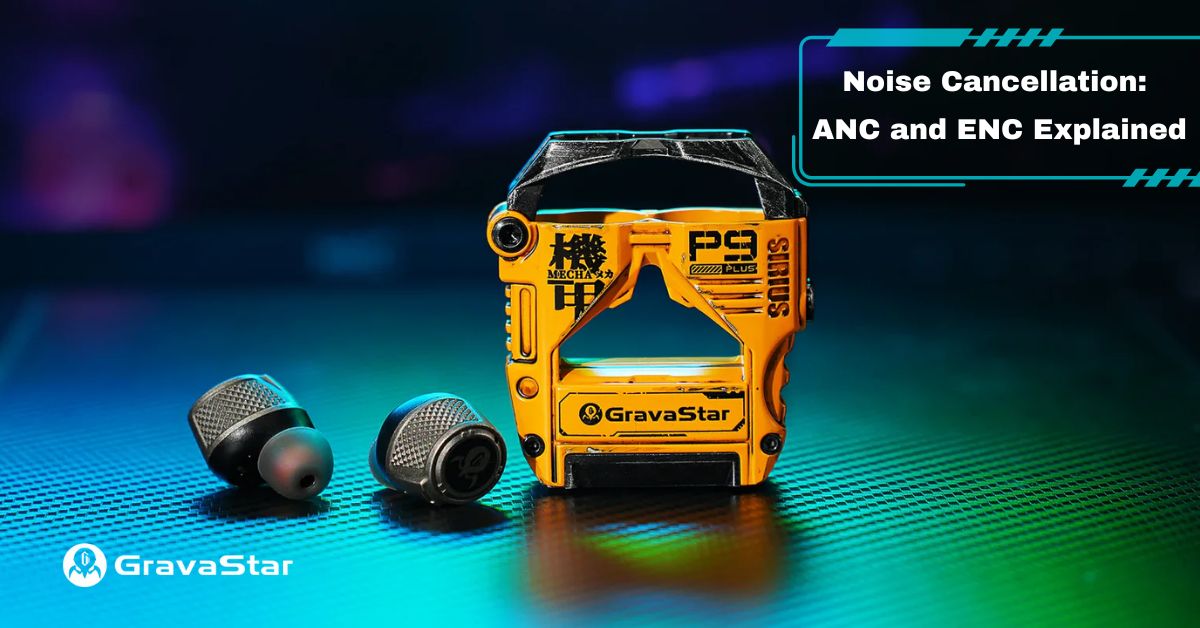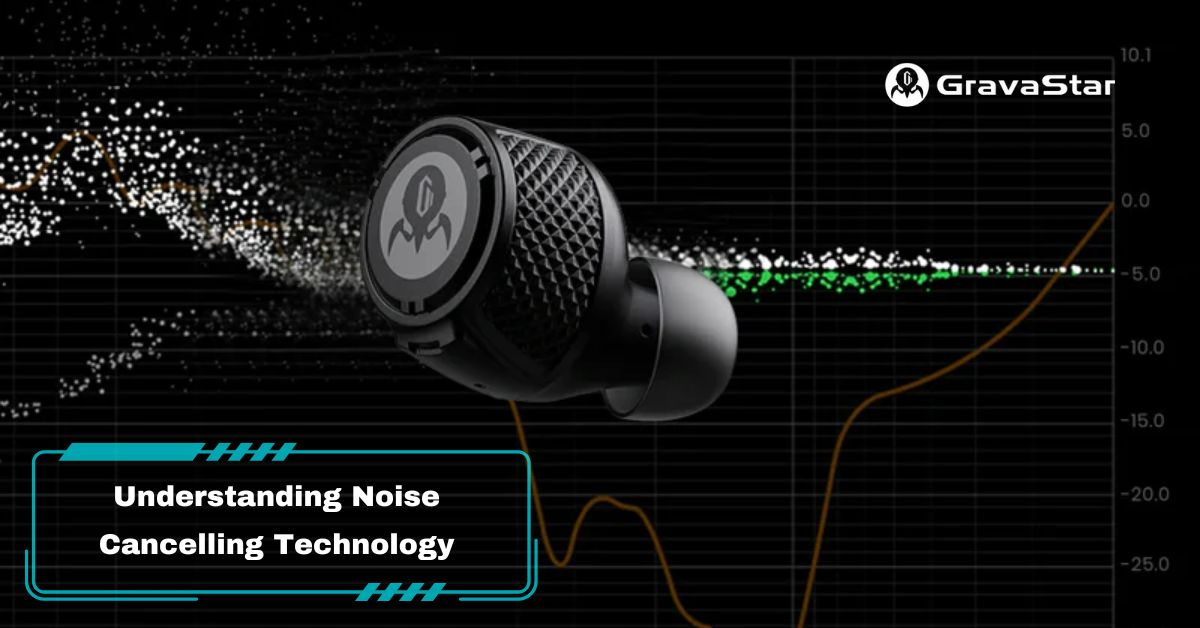Active Noise Cancellation (ANC) reduces unwanted ambient sounds in various environments, like offices, airplanes, and busy streets, to create a quieter experience for listening or focusing. Environmental Noise Cancellation (ENC) minimizes background noise during calls, making your voice clearer to the person on the other end.
According to the CDC, approximately 22 million workers in the U.S. are exposed to harmful noise each year. Of all workers, about 12% experience hearing difficulty, and 8% have tinnitus, a constant ringing in the ears.
Among noise-exposed workers who undergo testing, 20% have a material hearing impairment—hearing loss that affects daily activities—and 13% have hearing impairment in both ears.
Using ANC or ENC noise cancelling headphones may help protect your hearing by reducing background noise, allowing you to listen at lower volumes in loud environments.
GravaStar’s Sirius Plus earbuds are equipped with the latest Active Noise Cancellation technology, keeping your ears protected from harmful noise while providing superior sound quality.
What is Noise Cancellation?
Noise cancellation is a technology used in headphones and earbuds to minimize or block unwanted background sounds. It works by detecting external noise through built-in microphones and processing it with algorithms to produce sound waves that counteract the unwanted noise.
Types of Noise Cancellation: ANC vs ENC Explained
ANC reduces surrounding noise, while ENC headphones isolate your voice during calls. Here’s a more detailed explanation of ANC vs ENC and how they differ:
Active Noise Cancellation (ANC)
Active noise cancellation is a technology that reduces unwanted ambient sounds by generating sound waves that are the exact opposite (antiphase) of the incoming noise, effectively canceling it out.
This process gets rid of consistent ambient sounds, providing a quieter environment and an immersive experience when listening to music, podcasts, or other audio content.
How Does ANC Work?

Active noise cancellation reduces background noise by about 20 to 30 decibels (dB) by detecting ambient sounds with microphones and generating sound waves that cancel them. This process makes it easier to focus on audio in noisy settings like airplanes or crowded spaces.
-
Ambient Noise Detection: Small microphones embedded in the device pick up external sounds in the surrounding environment.
-
Wave Analysis: The captured noise is analyzed by internal processors, which measure the characteristics of the sound waves, including their frequency and intensity.
-
Anti-Noise Wave Creation: The system generates a new sound wave with the same frequency as the noise but reversed in phase. This “anti-noise” wave directly opposes the original sound.
-
Noise Neutralization: When the anti-noise wave meets the incoming noise, they cancel each other out through a process called destructive interference, creating a quieter audio experience for the user.
What are the Different Types of ANC Systems?

Different ANC systems reduce noise in distinct ways. Feedforward works by detecting external sounds, Feedback adjusts based on internal noise, and Hybrid combines both approaches to handle a variety of environments effectively.
|
Type |
Description |
Advantages |
|
Feedforward ANC |
External microphones are used to pick up noise from the surroundings before it reaches the ear. |
Handles a broad range of frequencies effectively, particularly steady sounds like office chatter or fans. |
|
Feedback ANC |
Internal microphones measure the sound inside the earcup to adjust the noise-canceling signal. |
Tailors noise reduction to the actual sound heard by the user, reducing unwanted low-frequency noise. |
|
Hybrid ANC |
Combines both feedforward and feedback ANC technology with microphones both outside and inside the ear phone. |
Offers more advanced noise cancellation across a wider frequency range, which is best for shifting sound levels. |
Environmental Noise Cancellation (ENC)
ENC noise cancelling is a technology that filters out background noise during calls or recordings by isolating your voice. It uses multiple microphones and algorithms to distinguish between speech and surrounding sounds, making sure only the voice is transmitted clearly to the listener.
How Does ENC Work?
Environmental noise cancellation uses multiple microphones and real-time digital processing to separate the speaker’s voice from background sounds, for clear audio transmission.
Microphone Array
ENC noise cancelling devices use multiple microphones to capture audio from both the speaker and the surrounding environment. Certain microphones focus on isolating the speaker’s voice, while others pick up ambient noise for analysis.
Digital Signal Processing (DSP)
Advanced digital algorithms process the captured sounds in real time, identifying and separating the speaker’s voice from background noise. This makes sure that the system accurately distinguishes speech patterns from unwanted sounds, like traffic or crowd chatter.
Noise Filtering
After analysis, the system suppresses ambient noise while preserving the speaker’s voice. This filtering means that only the clean, isolated voice is transmitted to the listener through ENC headphones, improving call clarity.
Real-Time Application
The entire process takes place almost instantly, allowing for seamless voice transmission during calls or recordings, even in noisy settings. This capability makes ENC noise cancelling highly effective when communicating in challenging environments.
ANC Vs ENC: What Are The Differences?

ANC uses multiple microphones located inside and outside the device to detect and process ambient sounds, working with processors to cancel noise through sound wave manipulation.
ENC noise cancelling uses a smaller microphone setup and relies on digital algorithms to isolate the speaker’s voice and reduce nearby background noise. ANC involves complex real-time processing for noise reduction, whereas ENC focuses on simpler processing methods designed for voice clarity.
Here’s a more detailed list of the differences between ANC vs ENC:
|
Feature |
Active Noise Cancellation (ANC) |
Environmental Noise Cancellation (ENC) |
|
Technology Focus |
Cancels unwanted ambient background noise for you by using sound waves that neutralize external sounds. |
Filters and isolates the speaker’s voice during calls, reducing background noise for clearer communication. |
|
Microphone Use |
Uses microphones inside and outside the device to detect noise and block it. |
Uses microphones to detect and lower background sounds during calls. |
|
Real-Time Processing |
Creates sound waves in real time that cancel out external noises. |
Filters out noise instantly during calls to make voices clearer. |
|
Voice Clarity |
Does not change how voices sound; it only reduces background noise for the listener. |
Improves how the speaker’s voice sounds during calls or meetings. |
|
Audio Quality |
Creates a better audio experience by blocking outside sounds during music or media playback. |
Focuses only on calls, not music or other media. |
|
Adjustable Settings |
Often allows the user to choose how much noise to block using an app or settings. |
Noise cancellation is automatic and cannot be adjusted. |
|
Adaptation to Noise |
Some earphones or earbuds adjust the noise cancellation level to match changing surroundings. |
Automatically changes the noise reduction level based on the environment during calls. |
|
System Complexity |
More advanced system using multiple microphones and sound waves to block noise. |
Simple system using fewer microphones and software to remove noise. |
|
Battery Use |
Uses more battery power due to constant noise blocking. |
Uses less battery because it needs simpler processing. |
|
Effectiveness |
It reduces steady noise levels by up to 30 dB, such as office chatter, train sounds, or household distractions, making it ideal for quiet listening. |
Reduces background noise by up to 20 dB during calls, improving voice clarity in noisy environments. |
|
Hardware |
It provides a quieter experience, but the level of noise reduction may sometimes slightly alter the natural sound profile. |
Uses fewer microphones and relies on software algorithms to reduce noise and focus on the speaker’s voice. |
|
Device Types |
Found in high-end headphones and earbuds made for music and media playback |
Found in headsets, earbuds, and devices for communication. |
|
Cost |
Devices with ANC are more expensive, ranging from $150 to over $400. |
Usually built into devices at no extra cost. |
|
Best For |
Immersive listening in noisy environments. |
Clear voice communication in various settings. |
Noise Cancellation: ANC and ENC Explained | FAQs
ANC Vs ENC: Which One Is Common in Everyday Consumer Devices?
ANC is widely used in devices like headphones and earbuds designed for high-quality audio playback and reducing ambient noise. ENC is more common in communication tools such as mobile phones and conferencing systems, where clear voice transmission is the main focus.
Does Noise Cancellation Through ANC or ENC Remove All Background Noise?
Noise cancellation with ANC and ENC cannot completely eliminate all background noise. While ANC reduces consistent low-frequency sounds and ENC minimizes nearby distractions during calls, neither can remove sudden or complex noises entirely.
Can an Earbud Have Both ANC and ENC?
Yes, an earbud can have both ANC and ENC. ANC reduces external noise for a better listening experience, while ENC noise cancelling minimizes background sounds during calls to improve voice clarity.





Leave a comment
This site is protected by hCaptcha and the hCaptcha Privacy Policy and Terms of Service apply.